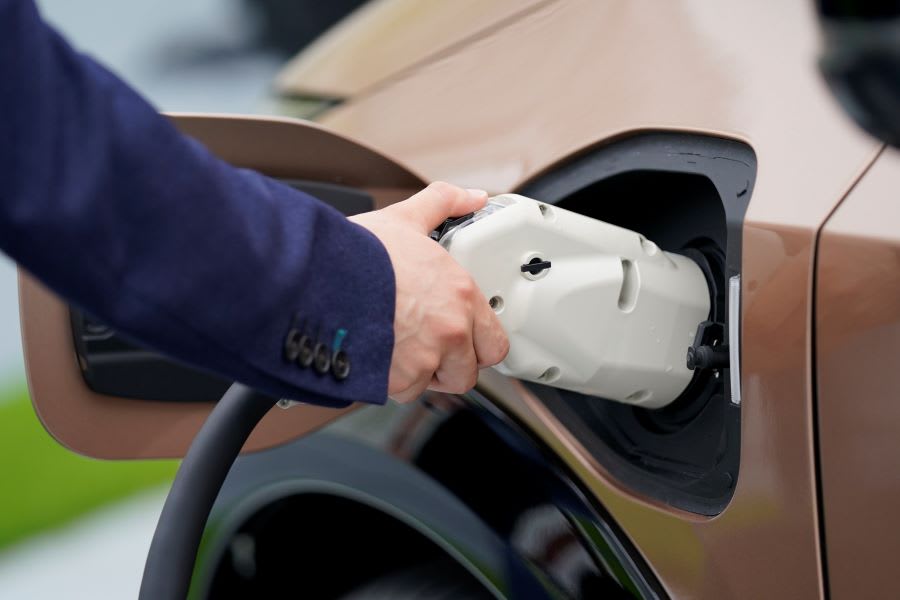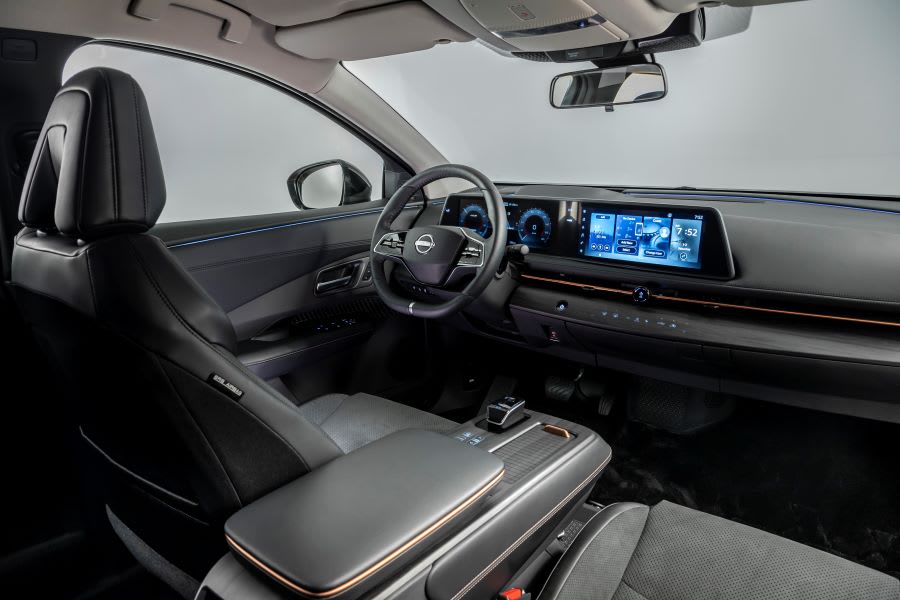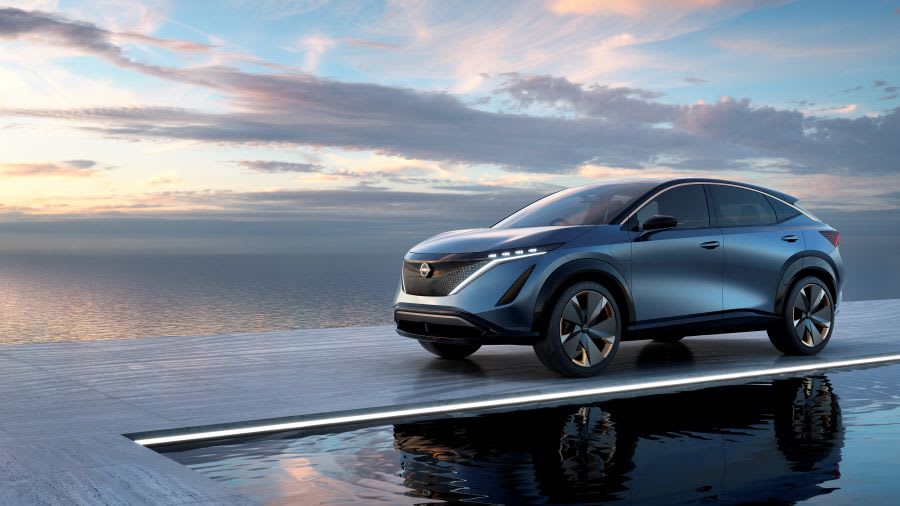
Nissan Ariya review

Introduction
No, we can’t believe where the time has gone, either. It has indeed already been 12 years since Nissan launched its first all-electric car.
Much as Toyota’s Prius was the groundbreaker for hybrids, the Nissan Leaf provided the launchpad for engineless, all-electric cars, with countless manufacturers following suit.
Select's rating score* - 3.7 / 5
At A Glance
It seems odd, then, that it has taken so long for Nissan to follow up with its next all-electric offering. However, we hope that such a long period has given it time to review the Leaf’s strengths and weaknesses to ensure its replacement is superior.
Finally, the wait is nearly over, and the Ariya – a compact crossover SUV – is arriving soon. According to Nissan, contrary to recent reports, it insists it is still on course for a summer 2022 launch date in the UK.
Fingers crossed it is worth the wait, then.
Early signs are positive: firstly, its Ariya concept car, which was shown off in Tokyo a couple of years ago, created quite a stir. Secondly, the actual vehicle looks virtually identical to the concept car. And thirdly, it is built on an entirely new platform.
The front is as imposing as it is big. The vehicle boasts a massive false grille, which creates a beaming smile from ear to ear, with boomerang-shaped day running lights tucked underneath. These stretch from the sides to the number plate.
The main headlights are thin and run alongside a blackened strip. Meanwhile, two slits on either side act as air intakes, with a broader but shorter lower grille creating an athletic stance.
The wavy bodywork design extends around the sides, too, where the side skirt angles upwards towards the middle before dropping off towards the rear wheel arches. The doors are sculpted with a curved indentation while the roofline drops aggressively at the back, meeting the top of the rear windscreen.
This continues an uninterrupted curve downwards towards the back of the car.
.png)
At the rear, the new Nissan looks a bit like a Jaguar E-Pace, only a bit meatier. The model’s backside sticks out towards the bottom and the top and has a strip of LEDs spanning the width of the boot. The number plate sits underneath this, with ample blank space beneath it. A deep roof spoiler overhangs the back windows, too.
We suspect the looks at the front will divide opinion. The Nissan has charisma, although some may think it is not pleasant.
The all-new Ariya is not available yet, so we are driving a pre-production prototype. Therefore, it is worth bearing in mind that some details might have changed by the time it fully hits the auto market.
Key Features
There are four main versions of the Nissan Ariya to choose from.
The entry-level is the Advance, which includes 19-inch wheels, LED headlights, dual-zone climate control, heated front seats, and a 360-degree camera. You also get a heat pump for warming the cabin quickly. Furthermore, it comes with a front-wheel drive.

Next up is the Advance with Sky Pack. The grade is almost the same as the Advance, but it includes a panoramic sunroof. So, it is effectively the Advance with an optional extra on it, but Nissan is marketing it as a separate trim.
The Evolve also includes the sunroof but upgrades the car to a larger battery and throws in a Bose sound system and ventilated front seats.
All the above are single motors, but the top-of-the-range e-4orce trim is a dual-motor, so it includes four-wheel drive and a significant power increase.
Range & Batteries
There are a couple of batteries available – 63kWh and 87kWh. Want to know more about how that translates? Read our guide on what kW and kWh really means.
The Advance and the Advance with Sky Pack trims get the lower capacity 63kWh battery with a claimed range of around 223 miles.
The Evolve and e-4orce trims get a larger 87kWh battery, which claims a range of 310 miles with Evolve and up to 285 miles with the e-4orce.
.png)
The actual range you will achieve depends on many factors, including driving style, weather conditions and temperature, so if you're worried about how an EV will fare, we've got a guide running through electric car range.
None of the quoted ranges in the Ariya is lame, but some manufacturers are cracking the 300+ mile mark now. So, Nissan, with most of its models offering less than that, may find this is a setback to the Ariya's hopes, especially as the real-world range is likely to be less than claimed.
Performance & Drive
The basic Nissan Ariya produces 217PS and manages nought to 62mph in 7.5-seconds.
Upgrade to the Evolve, and you will get 242PS. However, due to the weight of the additional batteries, the zero to 62mph time is marginally slower at 7.6-seconds.
The top-of-the-range e-4orce has 306PS and gets up to 62mph from a standing start in 5.7-seconds.

We drove a prototype of the entry-level model.
It didn't feel especially quick when accelerating, but it gets up to speed without a fuss, and the power is more than adequate for making good progress.
It feels refined and responsive when accelerating on the move, while there is always enough in reserve to make overtaking relatively easy.
In terms of ride and handling, we were driving on a private track as Nissan didn’t want its prototype going on the public road yet. But the ride quality is decent with precise and direct steering, which is light and responsive, but firms up at higher speeds.
Given we were on a track, we could test it going quickly around corners and found that the body roll is well controlled.
Certainly, it is no sports car, but the handling is impressive for a vehicle of its shape and size. However, we will reserve final judgement for when we can get on proper British roads that have significantly more potholes.
Electric cars also have regenerative braking, which converts energy that would otherwise be lost under deceleration, putting some charge back into the batteries.
The Ariya’s is among the best we have tried. Regenerative braking can often feel unnatural and inconsistent, but the Ariya’s is very consistent and intuitive
Charging
The Ariya has a maximum charging speed of 130kW.
Like the range of its batteries, it isn’t bad, but some manufacturers can top up the juice more quickly than this, including the Kia EV6, which can charge at 233kW.

The lower-powered 63kWh battery will take around 30 minutes to get from 10 to 80 per cent at full charging speed, with the 87kWh battery taking approximately five to ten minutes longer.
For home charging, a 7kW wall box will get you from empty to full in approximately ten hours with the 63kWh battery, with the 87kWh variant taking around 14 hours. To get the most out of your charger, consult our guide on picking your ideal electric car charger.
Running Costs & Emissions
Being all-electric, there are no fuel costs to worry about, as filling your car up at a petrol station becomes a thing of the past.
In addition, while we don’t know servicing details yet, electric cars have fewer moving parts, so they don’t need maintenance check-ups as frequently. Therefore, this is likely to help save you money.
.jpg)
Zero emissions mean zero pounds to pay in road tax (at least for the moment), while company car tax is minimal, too.
Of course, one thing we can't comment on is reliability – the car is simply too spanking-new to know how it will perform long-term. But East Asian brands such as Hyundai, Kia, Honda, and Toyota have solid reputations for dependability – and Nissan tends to be right up there, too.
Interior & Technology
Having seen Nissan’s usual levels of interior quality, we were beginning to think that it would only create a decent interior when pigs fly.
So, we weren’t expecting much, even though the automaker has steadily improved over the years and isn’t anywhere near as bad as it was.

Anyway, we ended up being very pleasantly surprised. The interior is, well, quite posh.
It may not look quite as upmarket as an Audi or a BMW, but show a picture of the all-new Ariya to a friend (you may need to hide the badge on the steering wheel), and they will never guess it is a Nissan.
There is a lovely dark wood finish beneath the infotainment screen and on the centre console, both of which feature illuminated haptic touch buttons. Admittedly, this isn’t as user friendly as having switches you can physically feel without looking, but it sure looks nice.
The centre console is separated from the dashboard, creating more free space, while the gear selector sits on top of the console like a computer mouse. Then you get the steering wheel, which is bold and sporty, featuring a piano black finish and a flat bottom.

The infotainment screen is merged into the same single unit that houses the digital instrument display. Both are 12.3-inch screens, with the infotainment screen being touch-sensitive. The system itself is responsive and easy enough to use. The graphics are clear, although it is not the highest resolution screen we have seen.
Apple CarPlay/Android Auto is included on all trims, and you can charge your phone up wirelessly. You also get a ProPilot system which has adaptive cruise control and a voice assistant, a bit like Nissan’s attempt at creating its own ‘Amazon Alexa’.
Elsewhere, there are soft-touch surfaces everywhere, including a suede-like finish on the top of the doors and the dashboard. Plus, there is a patterned finish on the lower half of the doors.
LED strips run along the windscreen and onto the doors, too. It looks lovely, well designed and well thought out.
A desirable Nissan interior? That flying pig has just gone past the window.
Practicality & Boot Space
Because this is a clean-sheet design that was built from the ground up to be an all-electric car, Nissan has been able to take advantage of not needing the conventional mechanics of a fossil-fuelled vehicle to maximise the available space inside.
There is a lot of space upfront, so you don’t feel claustrophobic when driving, with plenty of leg and headroom.
Finding a comfy driving position is very easy, thanks to the standard motorised seat adjustment, while there is plenty of play in the steering wheel to position it to suit.
The aggressively sweeping roofline does somewhat limit headroom in the back, but only taller adults will find it a struggle. Thankfully, there is a load of legroom, so this should mean they can stretch out and sit a little bit lower down, which might make a difference.
There is no hump in the middle of the floor either, so that might help make things a little bit easier, too.
If rear headroom is essential, it might be a good idea to do away with the panoramic sunroof, which, when fitted, usually knocks an inch or two off the available space.
All the seats are comfortable, if a little on the firm side.

In terms of storage space, there is plenty in the front, with room in the centre console, while the door bins are generously sized. There are two cupholders in the front, too, although the glove compartment is a bit on the small side.
One pleasing feature is that, at the touch of a button, a tray sprouts out from the dashboard, on which you can rest a tablet or laptop.
The boot opens by itself thanks to the powered tailgate. This reveals 466-litres of space, which is smaller than most of its nearest rivals – and that drops down to 402-litres if you choose the four-wheel drive version.
In truth, unless you are planning on moving a piano, it should still be more than adequate for the weekly shopping.
The rear seats fold away in a 60/40 split, although Nissan hasn't revealed how much extra cargo space this leaves you with.
There is some additional storage underneath the floor, where you can keep the Ariya’s charging cables, but unlike in some electric cars, there is no spare space to put anything underneath the bonnet.

Safety
Safety body Euro NCAP is yet to crash-test a Nissan Ariya, so we cannot tell you how safe it is just now.
However, the latest version of the Nissan Leaf – the company’s only other all-electric car – was tested back in 2018 and earned a five-star rating. It scored 93 per cent for adults, 86 per cent for children and 71 per cent for safety assists.
Of the seventeen Nissans tested since 2010, nine have scored five stars, six have recorded four stars, while two have notched up three stars.
Safety systems include lane-keeping assistance and Nissan’s Safety Shield. The latter is a collision warning system that encompasses lane departure warning, automatic emergency braking, blind-spot warning, high beam assist, traffic sign recognition, hill start assist, and rear cross-traffic alert, amongst others.

Options
There are very few options available for the all-new Nissan Ariya.
You can add a Bose sound system to the lower trims (it is included as standard higher up the range), but that is about it.
Nissan pulls the usual trick of charging you more if you want any colour other than extremely dark green. Grey metallic is a few hundred pounds extra, while black or a different shade of grey is even more expensive.
There is a selection of two-tone colours, which come with a black roof. For these, copper, silver or red all cost over a grand, while burgundy, white and blue will set you back a little more.
For the interior upholstery, black is included, but grey costs a few hundred notes, and blue is over the grand mark.

Rival Cars
The most obvious competitors to the Nissan Ariya include the Kia EV6 and the Skoda Enyaq.
Both are excellent cars and will provide a formidable challenge to Nissan – especially as both are marginally cheaper.
As we have seen, though, the Ariya is more than capable of holding its own.
Other models you might want to consider leasing include the Volvo C40, and the Tesla Model Y. Mind you, the Volvo is a bit pricier, and the Tesla is quite a lot more expensive.
Verdict & Next Steps
The Ariya stands a chance of being the best everyday Nissan ever.
It has certainly got the best interior, and it is a big step forwards in the company’s all-electric evolution from the Leaf.
The interior is delightful, and the exterior looks are funky – certainly at the rear. However, some folk in the office disagree when it comes to the front end.
The all-new Ariya has a decent amount of power, handles reasonably well, stops just as well, and will almost certainly take a chunk out of the market share of its rivals.
Most of its challengers have longer ranges and faster charging speeds, while if rear headroom and boot space are priorities, you may be forced to look elsewhere.
Nevertheless, it is nice to finally have a Nissan family car that we can say is impressive, sophisticated, and desirable.
Where to next?
View our latest Nissan Ariya Leasing Deal - from just £484.94 per month inc VAT**
Looking for a great leasing deal? Check out our incredible range of Special Offers
New SUV? Read our latest Car Reviews and find the right model for you
Want to know more about leasing? Take a look at our comprehensive Leasing Guides
Interested in everything motoring? Why not catch up on all the latest Car Leasing News.
*Score based on Select’s unique meta score analysis, taking into account the UK’s top five leading independent car website reviews of the Nissan Ariya
**Correct as of 19/04/2023. Based on 9 months initial payment, 5,000 miles over a 48 month lease. Initial payment equivalent to 9 monthly payments or £4,364.46 Ts and Cs apply. Credit is subject to status.
{ "@context": "http://schema.org", "@type": "VideoObject", "name": "Nissan Ariya Review - Select Car Leasing", "description": "This week, we took the Nissan Ariya out for a spin. The cutting-edge Ariya is Nissan’s first all-electric SUV, complete with futuristic exterior styling and a cabin designed to mimic the interior of a spaceship. The Ariya slots into Nissan’s electric-powered range alongside the Leaf hatchback and the E-NV200 Combi MPV. stepping inside the Ariya is the equivalent of taking a seat inside a ‘sleek cafe lounge on a starship’. There are slimline ‘Zero Gravity’ seats that provide great legroom while the dash features large 12.3 inch haptic touchscreens. Next up, we’ve got the BMW i4 to check out to ⚡ so stay tuned. To lease the Nissan Ariya with us today, click this link 👉🏻 https://eu1.hubs.ly/H03dFsz0 #carreview #carreviews #electriccars #electricvehicles #selectcarleasing #leasing #ElectricSUV #nissan #nissanariya #ariya #aryastark #arya #gameofthrones #nissanreview #nissanfanclub #nissanownersclub #fullyelectric #thesustainabledad #generatemedia #electric #travel #sustainable Sections: 00:00:00 - Intro 00:00:24 - First impressions 00:00:41 - Interior 00:01:02 - Phone charging 00:01:26 - Charging port 00:01:43 - Boot 00:02:10 - Wheels and Exterior Design 00:02:30 - Frunk? 00:02:40 - Trim levels 00:02:51 - Charging rates and Range 00:03:03 - 0-60 00:03:09 - Handling and Regen 00:03:19 - Storage 00:03:31 - Interior design 00:03:41 - Comparisons 00:03:56 - Summary", "thumbnailUrl": "https://i.ytimg.com/vi/PLUvSjSruEE/maxresdefault.jpg?sqp=-oaymwEmCIAKENAF8quKqQMa8AEB-AH-CYAC0AWKAgwIABABGEsgWihlMA8=&rs=AOn4CLAa6w2KqN20izVhkv4Yumz6N2XN6A", "uploadDate": "2023-03-20T09:30:02-07:00", "duration": "PT4M13S", "embedUrl": "https://www.youtube.com/embed/PLUvSjSruEE", "contentUrl": "https://www.youtube.com/watch?v=PLUvSjSruEE", "interactionCount": "3418" }


















